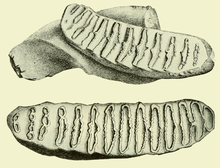| Loxodonta atlantica Temporal range: Late Pliocene to Middle Pleistocene | |
|---|---|
 | |
| Scientific classification | |
| Domain: | Eukaryota |
| Kingdom: | Animalia |
| Phylum: | Chordata |
| Class: | Mammalia |
| Order: | Proboscidea |
| Family: | Elephantidae |
| Genus: | Loxodonta |
| Species: | †L. atlantica |
| Binomial name | |
| †Loxodonta atlantica Pomel, 1879 | |
Loxodonta atlantica is an extinct African species of elephant in the genus Loxodonta (which includes living African elephants). It was larger than modern African elephants, with more progressive dentition. [1] It includes Pleistocene fossils from Ternifine, Algeria, [2] Middle Pleistocene fossils from Elandsfontein, South Africa and Late Pliocene fossils from the Omo River, Ethiopia. [3] It is suggested to have an extinction date of around 400,000 years ago, during the Middle Pleistocene. [4] L. atlantica has been suggested to have probably derived from L. adaurora ; [5] or L. exoptata. [6] It is likely ancestral to the living African bush elephant, L. africana, [6] with which it coexisted during the Middle Pleistocene prior to its extinction. [3] The species is divided into two subspecies: L. atlantica atlantica (northern Africa) and L. atlantica zulu (southern Africa). [5] The type for Loxodonta atlantica is housed in the Muséum national d'histoire naturelle in Paris, but is listed without a specimen number. [6]